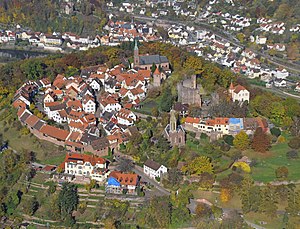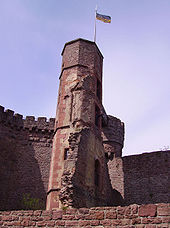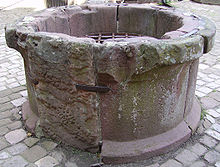Mountain fortress Dilsberg
| Mountain fortress Dilsberg | ||
|---|---|---|
|
Aerial view of the Dilsberg mountain fortress |
||
| Creation time : | 1150 and 1200 | |
| Castle type : | Hilltop castle | |
| Conservation status: | Received or received substantial parts | |
| Standing position : | Count | |
| Place: | Neckargemünd | |
| Geographical location | 49 ° 23 '55 .5 " N , 8 ° 50' 13.5" E | |
| Height: | 288.6 m above sea level NN | |
|
|
||
The Dilsberg mountain festival is a high medieval mountain festival east of Heidelberg in the Rhein-Neckar district in Baden-Württemberg , from which the Dilsberg district of the city of Neckargemünd has developed.
location
The hilltop castle is 288.6 m above sea level. NN over the Neckar valley and the Kraichgau . It was part of the fortifications of the Electoral Palatinate .
history
A predecessor of today's mountain fortress was built between 1150 and 1200 - probably as a residential tower - which is indicated by the reused humpback blocks in today's masonry . The castle was first mentioned in 1208 in connection with Boppo (V.) von Lauffen , who may have inherited it from his brother Konrad, who died early. The castle could already have been a residence of Boppos (IV.). It is possible that the Counts of Lauffen were previously in Wiesenbach . Via Dilsberg Castle, the Counts of Lauffen demonstrated their presence to the Count Palatine in Heidelberg and in the direction of Elsenzgau , but it was strategically less important for the Lauffeners than Lauffen , Hornberg and possibly Eberbach .
After this family died out, the Counts of Dürn came to power, who had been called Counts of Dilsberg since 1252 . Around 1300 the castle became the property of the Electoral Palatinate , under whose direction the castle was extensively rebuilt from the 1330s.
In 1572, the two Unitarians Matthias Vehe-Glirius and Jacob Suter were imprisoned at the mountain festival because of their anti-Trinitarian views.
In the Thirty Years War it was one of the most contested fortresses. In 1622 the fortress was occupied by the general Tilly after a long siege. In 1633 the Swedes recaptured the fortress. Despite the siege and fighting, the fortress itself was neither conquered nor destroyed militarily.
In 1803, at the end of the Electoral Palatinate, the Dilsberg mountain fortress and the town fell to the state of Baden and served as a state prison. In 1822 it was released for demolition.
At the beginning of the 20th century, the Dilsberg mountain fortress gradually developed into a destination for tourists. The small fortress was extensively renovated and reconstructed for this purpose. The underground, about 80 meters long water supply tunnel , which was in 1896 rediscovered by Fritz von Briesen and exposed in 1926, is one of the special features of the parties.
Todays use
The mountain fortress Dilsberg is open for sightseeing. It is one of the state's own monuments and is looked after by the State Palaces and Gardens of Baden-Württemberg . The regular events such as the Dilsberg arts and crafts market, the Dilsberg castle concerts and the open-air stage performances of the Rose vom Dilsberg in early summer are cultural highlights . There is also a youth hostel here .
description
investment
The castle complex is divided into fore and main castle . The outer bailey included the disabled barracks (now a garden), the tithe barn , the stables with the fruit store and the commandant's house.
The outer line of defense is the city wall of Dilsberg, shaped as a mountain crown .
In order to get into the main castle, two flanking towers had to be passed. In the courtyard of the main castle were the palas , of which only a cellar vault has survived, and an octagonal stair tower approx. 19 m high . The up to 16 m high ring wall used to surround the entire main castle before the eastern and southern parts were demolished.
In 1842 the people of Dilsberg also wanted to grind the city gate in order to save on maintenance costs. However, this was forbidden to them by the Heidelberg building authority of the state of Baden , which was of the opinion “that the demolition of the city gate would be detrimental to the 'overall impression' of the Dilsberg”; In addition, it is to be feared that in the event of the city gate being dismantled, the ringing of the citizens' bell to be relocated to the Catholic Church in the field would no longer be heard.
Dungeon
In the area of the castle there is a basement vault for a time as punishment cell of the University of Heidelberg served. It later became a military detention center .
Fountain
The castle well with a crankcase for the water bucket is about 46 meters deep and was probably built after the castle was built around 1150 with a depth of 21.50 meters. The meager water supply was reserved for the castle crew only. The villagers had to get their water elsewhere.
In a second construction phase, probably between 1650 and 1680, the fountain was widened and deepened, as a castle garrison, which had been greatly enlarged by the establishment of a garrison in the Electoral Palatinate, had to be supplied with water. It is noteworthy that presumably no blasting was carried out in either construction phase, but rather the whole work was done with mallets and iron .
Burgstollen
The castle tunnel was created using the separating joints in the rock, which is why the sole and ridge are pointed. The tunnel was driven into the mountain from the outside and should meet the well shaft after 65 meters. However, the miners repeatedly deviated from the direction. Therefore the total length of the tunnel is 78 meters.
Dilsberg local history researchers previously assumed that the tunnel was built so that the castle crew could escape outside during sieges. Today, however, it is believed that the passage was a ventilation tunnel.
After the tunnel had served its purpose of protecting the workers from poisonous gases, it was temporarily filled in. Then the legend of the underground passage was formed, which should lead under the Neckar to a Neckarsteinach castle. The writer Mark Twain mentioned this legend in his travel story A Tramp Abroad (in German: Bummel durch Europa ). The story inspired the German-American Fritz von Briesen around 1900 to travel from New York to find the tunnel. He let himself down and actually found the tunnel exit. With his financial help, the well and the tunnel were cleared of rubble and the beginning of the tunnel was exposed in the forest.
Observation tower
The octagonal stair tower that used to stand on the west wall of the palace is made of sandstone blocks and divided into four levels by slightly cantilevered circumferential bands. A right-turning sandstone spiral staircase with 95 steps leads past the now secured door openings, which formerly led to the various floors of the palace, up to the approx. 18 m high viewing platform , which is currently inaccessible because the top part of the staircase is locked with a door. At a height of about 13.5 m there is an exit to a wooden bridge that connects the tower with the mantle wall , a ring wall up to 16 m high , from which one has a panoramic view of the place and the Neckar valley . The curtain wall originally enclosed the entire main castle , but is largely destroyed to the east and south.
Say
The bees from Dilsberg
According to the story, the Count von Dilsberg was on the hunt and his enemies wanted to use this to conquer the castle. The few farmers who were at home could hardly resist them. So they had an idea and got their beehives. Then they took it up behind the city wall. When the attackers got close enough, the farmers shook the beehives and released the irritated bees on the attackers, successfully repelling the attack. The "bee garden" on the city wall still reminds of this incident today .
The rose from Dilsberg
The rose from Dilsberg commemorates the daughter of Count Heinrich von Düren, who had a sad fate because two knights asked for her hand, a Landschad von Steinach and a knight Wolf von Hirschhorn . When it turned out that she was fond of the knight Wolf, the rejected suitor swore revenge and killed Knight Wolf on the way to Dilsberg from behind. The final preparations for the wedding were already underway at the castle and no one dared tell the bride about the crime. When a servant reported the tragedy to the bride, she threw herself from the castle wall. Since then, a large rose bush with white roses has been growing at the place where her body was found.
Personalities
- Karl von Zyllnhardt (1744–1816), landlord in Mauer and head of the Bavarian General Forest Administration.
literature
- Christoph Bühler: Castles of the Electoral Palatinate. Bergstrasse and Neckar Valley . Heidelberger Verlagsanstalt, Heidelberg 1990. pp. 121 ff. ISBN 3-89426-012-2
- Jochen Goetze, Werner Richner: Castles in the Neckar Valley . Ed. Braus, Heidelberg 1989. ISBN 3-925835-52-0
- BH Hottenroth: The rose of Dilsberg - legend and drama from the Neckar valley - a dramatic legend from the 12th century . A brochure with pictures and text since the first performance in 1910 in the romantic Dilsberg castle complex. Self-published by Frans Herrmans, o. O. 2000.
- Axel W. Gleue: How did the water get to the castle? From building wells to hilltop castles and mountain vests . Schnell + Steiner publishing house, Regensburg 2008, ISBN 978-3-7954-2085-7 , pp. 167-176;
- Wolfgang W. Kress: Castles and palaces on the Neckar. From Esslingen to Mannheim . DRW publishing house. Stuttgart 1991. ISBN 3-87181-259-5
- Heinrich Niester: Castles and palaces in Baden. Based on templates from old times . In: castles, palaces, mansions. Volume 18 . Weidlich, Frankfurt am Main 1961
- Adolf von Oechelhaeuser (arrangement): The art monuments of the Heidelberg district (Heidelberg district) . (The Art Monuments of the Grand Duchy of Baden, Volume Eight, Second Section). Tubingen, 1913
- Otto Piper: Castle studies. Construction and history of castles . new, improved and enlarged edition, reprint of the 3rd edition. Piper, Munich 1912. Weltbild-Verlag, Augsburg 1994. P. 522. Chapter Underground corridors . ISBN 3-89350-554-7
- Rhein-Neckar-Zeitung of January 13, 2006, p. 10. " The Commandant's House "
- Wolfgang Seidenspinner: Dilsberg, City of Neckargemünd . In: Heidelberg, Mannheim and the Rhine-Neckar area. Series “Guide to Archaeological Monuments in Germany”. S. 117 ff. Stuttgart: Theiss, 1999. ISBN 3-8062-1407-7 .
- Eduard Schuster: The castles and palaces of Baden . Verlag der Hofbuchhandlung Friedrich Gutsch, Karlsruhe 1908
- Thomas Steinmetz: Castles in the Odenwald . Schmid, Brensbach 1998. ISBN 3-931529-02-9
- Wolfgang Wiese: Dilsberg Castle Fortress. Leader . (State Palaces and Gardens of Baden-Württemberg). Braus, Heidelberg 2000. ISBN 3-926318-80-5
- Stefan Wiltschko: Dilsberg mountain festivals. Guide through the castle complex . Braus, Heidelberg 2000. ISBN 3-926318-80-5
Web links
- Official website of the Dilsberg Castle Fortress
- Site of Dilsberg Castle
- Dilsberg at burgen-web.de
- Dilsberg at Baukunst in Baden
- Dilsberg on palaces and castles in Baden-Württemberg
Individual evidence
- ↑ a b c d e Nicolai Knauer: The castles of the Counts of Lauffen in the Neckar valley . In: Christhard Schrenk, Peter Wanner (eds.): Heilbronnica 5 . Contributions to the city and regional history. Heilbronn City Archives, Heilbronn 2013, p. 100–102 ( PDF; 2.9 MB [accessed February 21, 2014]).
- ↑ Christopher J. Burchill: The Heidelberg Antitrinitarians . In: Bibliotheca Dissidentium . Baden-Baden & Bouxwiller 1989, p. 173 .
- ↑ Portrait of JH Dilsberg on jugendherberge.de Retrieved on July 24, 2020











